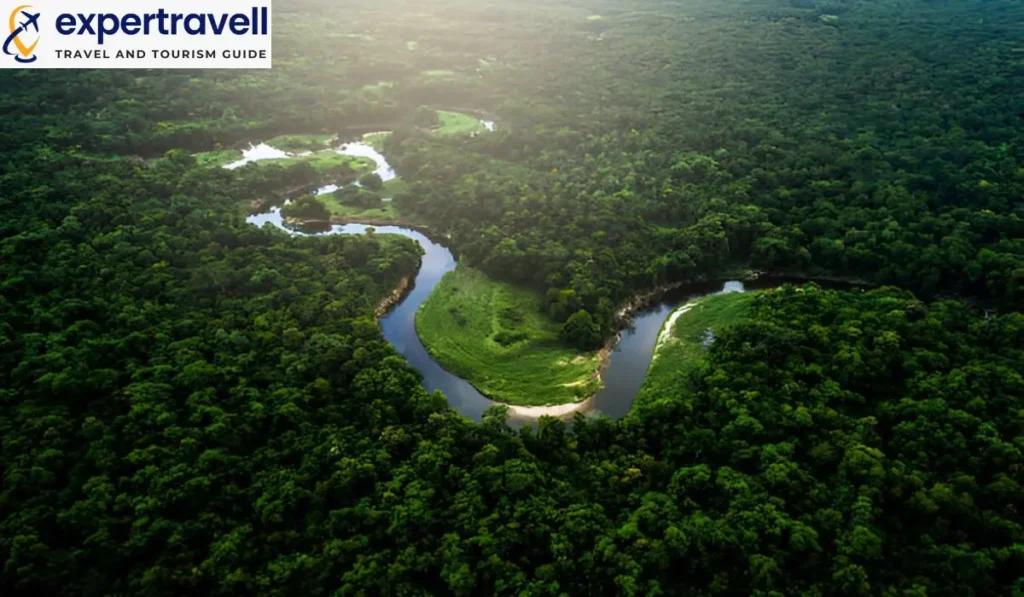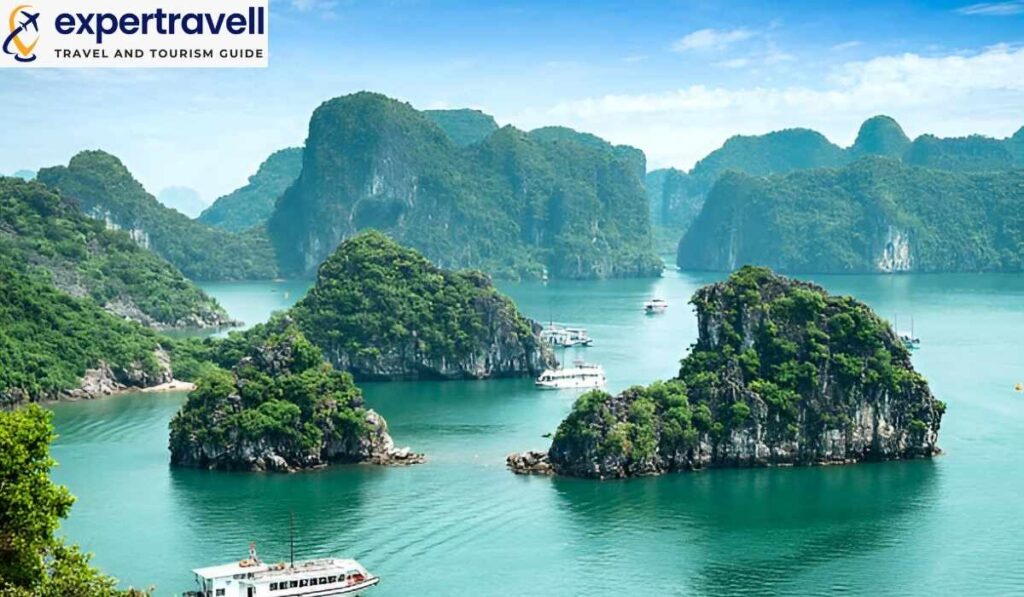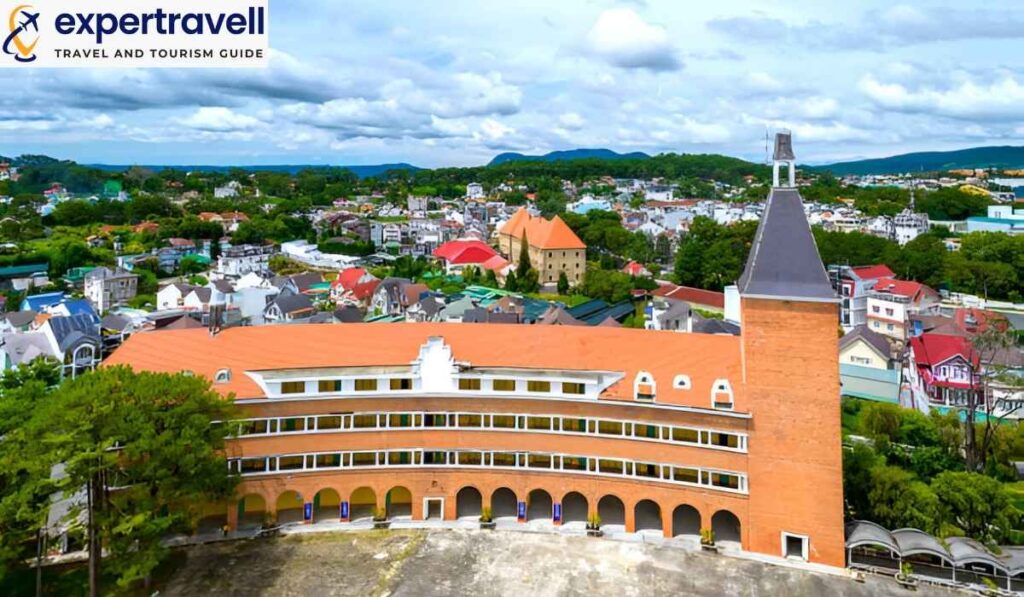The Amazon rainforest in Peru offers a unique chance to see nature at its wildest. Rare animals, giant trees, and tribal tales await the visitor. The Peruvian Amazon comprises more than 60% of the country and holds one of Earth’s most incredibly rich, biodiverse ecosystems.
The Peruvian Amazon is a place to watch colorful birds, playful monkeys, and pink dolphins. It has jungle lodges where adventure seekers can stay, boat rides through winding rivers, and hiking trails in dense forests. A few typical places to begin your Amazon experience are Puerto Maldonado and Iquitos.
The Amazon provides a large percentage of the Earth’s health. It has trees that clean the air and mitigate climate change as a result. The forest is responsible for 20 percent of the world’s oxygen. Unfortunately, it is an important ecosystem, which some groups see as neither fun nor one they wish to consider as essential as visiting a vibrant city like Amsterdam, Netherlands.
Best Time To Visit The Amazon Rainforest
The Amazon rainforest offers unique experiences year-round. Weather patterns and wildlife activity influence the ideal time for your visit.
Wet Season Vs. Dry Season
The Amazon has two main seasons. The wet season runs from December to May. It brings heavy rainfall and higher water levels. Rivers and streams swell, making boat travel easier. Some hiking trails may flood. The dry season lasts from June to November. Rainfall decreases and temperatures rise slightly. Lower water levels expose more land, ideal for hiking and spotting animals near water sources. Both seasons have pros and cons for visitors. Wet season offers lush vegetation and easier river navigation. Dry season provides better walking conditions and concentrated wildlife.
Wildlife Viewing By Season
Animal sightings vary by season. Wet season is great for bird watching. Many species are more active during this time. Fish are more abundant, attracting predators like caimans and river dolphins. Dry season concentrates animals around shrinking water sources. This makes them easier to spot. Mammals like monkeys and jaguars are more visible. Reptiles bask on exposed riverbanks. Migratory birds arrive in large numbers during transitions between seasons. These periods offer diverse wildlife viewing opportunities.
The Best Months For Exploration
July to September are often considered the best months to visit the Amazon. These months fall in the dry season. They offer a balance of accessibility and wildlife viewing. Water levels are reasonable, allowing both river travel and jungle hikes. The weather is slightly cooler and less humid. Rain is less frequent, but still occurs. May and November are good alternatives. They mark transitions between seasons. Visitors can experience aspects of both wet and dry conditions. Wildlife is active as they adjust to changing water levels.

How To Get To Peru’s Amazon Rainforest
Peru offers several entry points to its lush Amazon rainforest. Each destination has unique travel logistics and experiences. Travelers can choose from main cities or more remote locations.
Main Entry Points: Puerto Maldonado, Iquitos, Manu National Park
Puerto Maldonado is a popular gateway to the southern Amazon. It’s easily reached by air from Lima or Cusco. Flights take about 1-2 hours. Iquitos, the largest city in the Peruvian Amazon, sits in the north. It’s only accessible by air or boat. Daily flights connect Iquitos to Lima, taking about 1 hour and 40 minutes. Manu National Park, known for its biodiversity, is reached via Cusco. The journey involves a combination of road travel and boat rides.
Detailed Logistics For Each Destination
Puerto Maldonado:
- Fly to Padre Aldamiz International Airport
- Take a bus or taxi to the Madre de Dios River
- Board a boat to your jungle lodge
Iquitos:
- Fly to Coronel FAP Francisco Secada Vignetta International Airport
- Take a taxi to the city center or port
- Travel by boat on the Amazon River to reach jungle lodges
Manu National Park:
- Start in Cusco
- Take a bus to Atalaya (8-10 hours)
- Board a boat for a 4-6 hour ride to your lodge
Alternative Travel Options
For adventurous travelers, slow boat journeys offer a unique experience. From Iquitos, multi-day boat trips along the Amazon River are available. Overland routes to Puerto Maldonado exist but are challenging. The journey from Cusco takes about 10-12 hours by bus on partly unpaved roads. Some tour operators offer small plane services to remote airstrips in the jungle. These flights provide access to more isolated areas of the Amazon, making it an unforgettable adventure for those who also hope to see sea turtles in Kauai.
Top Amazon Rainforest Destinations In Peru
Peru offers several amazing entry points to explore the Amazon rainforest. These destinations provide unique experiences and opportunities to see diverse wildlife and lush jungle landscapes.
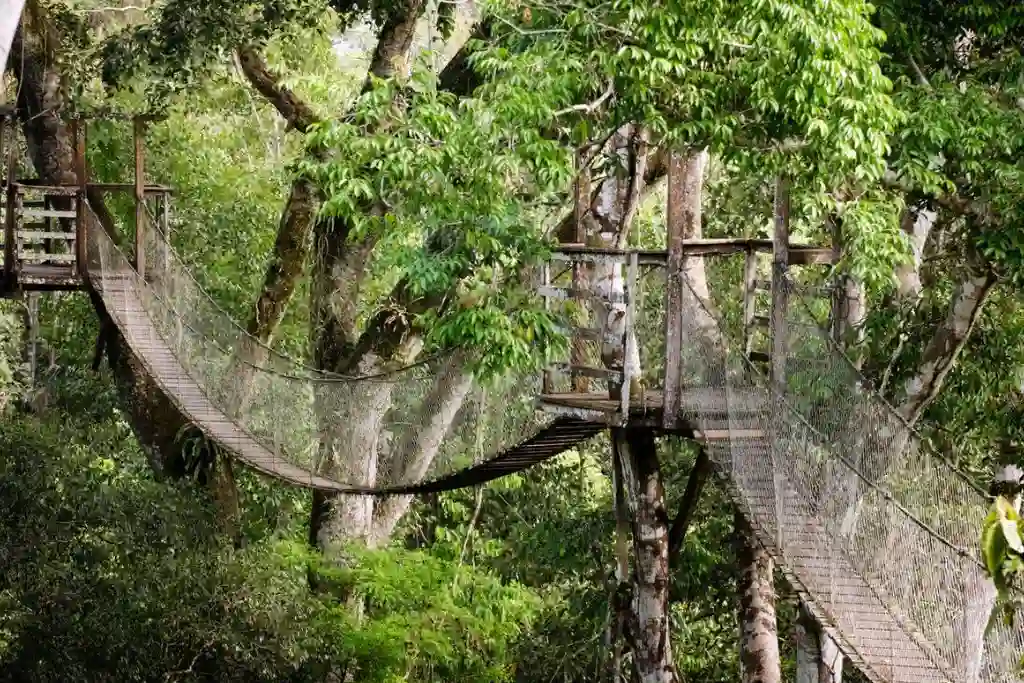
Puerto Maldonado
Puerto Maldonado serves as the gateway to the Tambopata Reserve, a biodiversity hotspot. This small city sits at the meeting point of two rivers, the Madre de Dios and Tambopata. Visitors can take boat trips to nearby lodges and eco-reserves. These areas offer chances to spot colorful macaws, playful monkeys, and even jaguars. Many tours include night walks to see nocturnal animals. Canopy walks give a bird’s-eye view of the forest. Fishing for piranhas is another popular activity. Puerto Maldonado is easy to reach. It has an airport with regular flights from Lima and Cusco.
Iquitos
Iquitos is the largest city in the Peruvian Amazon. It’s also the world’s largest city that can’t be reached by road. Visitors must arrive by plane or boat. The city serves as a starting point for trips to the Pacaya Samiria Reserve. This vast protected area is home to pink river dolphins, sloths, and many bird species. Iquitos itself has interesting attractions. The Manatee Rescue Center lets visitors learn about these gentle creatures. The Belen Market offers a glimpse of local life and exotic products. River cruises are a popular way to explore from Iquitos. These range from basic boats to luxury ships.
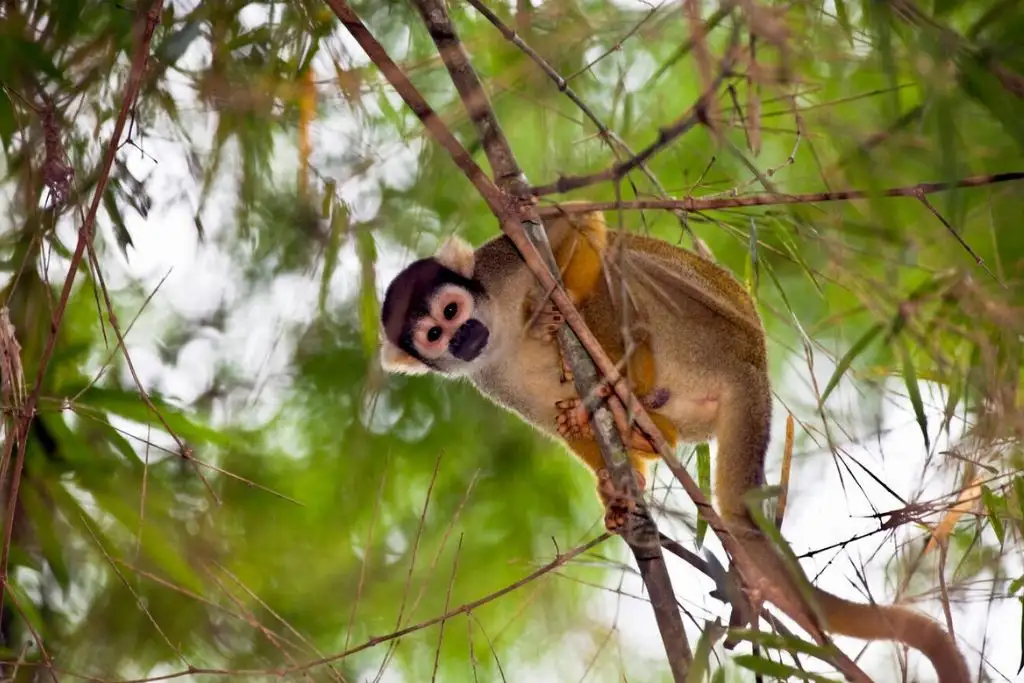
Manu National Park
Manu National Park is one of the most biodiverse areas on Earth. It covers a huge area from Andean mountains to lowland rainforest. The park is home to over 1,000 bird species and 200 mammal species. Visitors might see giant otters, tapirs, or even the elusive jaguar. Access to Manu is more limited than other areas. This helps protect its pristine ecosystems. Most trips start with a drive from Cusco, followed by a boat journey. Manu offers a chance to see both cloud forest and lowland rainforest. Guided hikes, canoe trips, and visits to observation towers are common activities.
Wildlife In The Peruvian Amazon
The Peruvian Amazon teems with an incredible variety of animals, birds, and plants. This rich ecosystem supports countless species, from colorful macaws to elusive jaguars. Many travelers come to spot rare creatures and experience the rainforest’s biodiversity firsthand.
Iconic Animals To Spot
The Amazon rainforest in Peru hosts over 35,000 species of plants and animals. Visitors often hope to see jaguars, though these big cats are shy and hard to spot. Pink river dolphins are more common sights in Amazonian waterways. These unique creatures have a pinkish hue and curved snouts. Capybaras, the world’s largest rodents, frequently appear near rivers. They can weigh up to 150 pounds. Sloths move slowly through the trees, while colorful poison dart frogs hop along the forest floor. Green anacondas are massive snakes found in slow-moving streams. They can grow over 29 feet long and weigh more than 550 pounds. These powerful constrictors sometimes prey on caimans and capybaras.
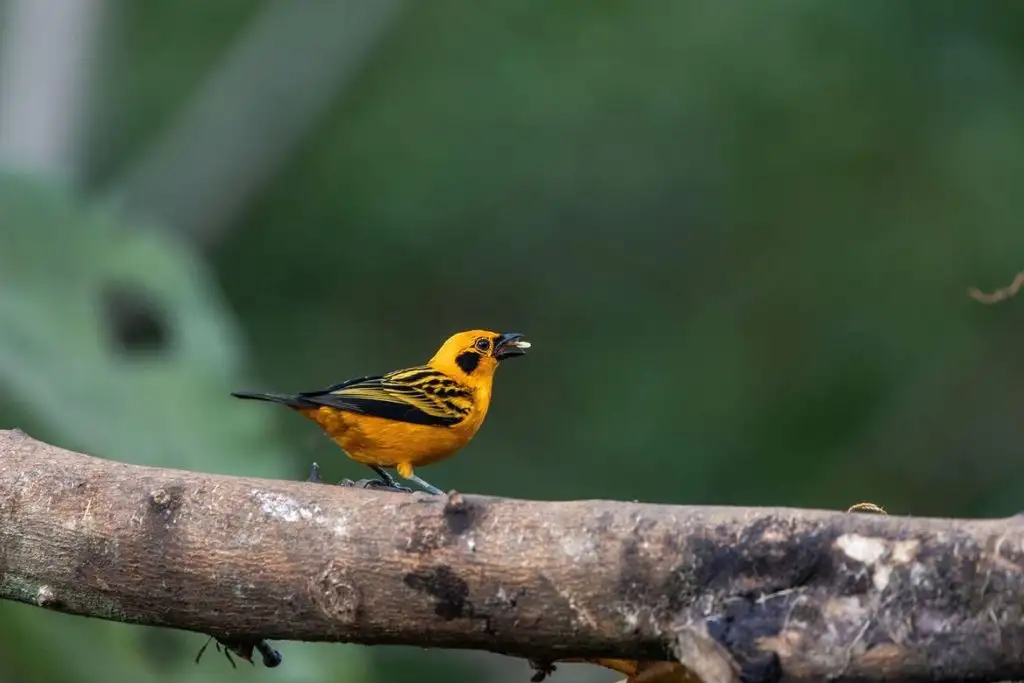
Birdwatching Highlights
Peru’s Amazon offers excellent birdwatching opportunities. Colorful macaws gather at clay licks, creating spectacular displays. Scarlet, blue-and-yellow, and red-and-green macaws are common sights. Toucans stand out with their oversized, colorful beaks. Several species inhabit the Peruvian Amazon, including the channel-billed toucan. Harpy eagles, among the world’s largest and most powerful raptors, nest in tall emergent trees.
Other notable birds include:
- Hoatzins
- Kingfishers
- Tanagers
- Hummingbirds
- Parrots
Serious birdwatchers can spot hundreds of species during a single trip to the Peruvian Amazon.
Rare And Endangered Species
The Peruvian Amazon provides refuge for many rare and threatened animals. Giant river otters, endangered due to past hunting, live in oxbow lakes and slow-moving rivers. These social mammals can grow up to 6 feet long. Black caimans, the Amazon’s largest predator, face threats from habitat loss. They can reach lengths of 20 feet. Jaguar populations are declining, but conservation efforts aim to protect these apex predators.
The yellow-tailed woolly monkey lives only in Peru. Deforestation endangers this primate species. Efforts to establish protected areas help safeguard these and other rare Amazonian animals, making Peru one of the best places to travel for beginners interested in unique wildlife experiences.Adventure Activities In The Amazon Rainforest
The Amazon rainforest offers many exciting activities for nature lovers and thrill-seekers. Visitors can explore the jungle’s diverse ecosystems and encounter unique wildlife through various adventures.
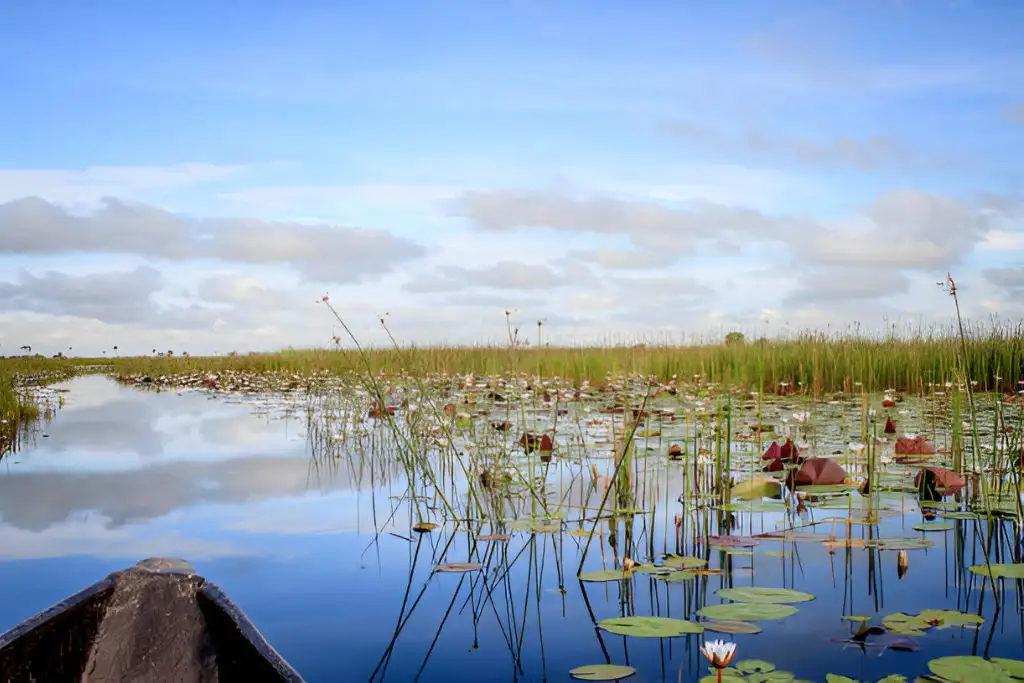
River Safaris And Canoe Tours
Amazon boat cruises let travelers see the rainforest from a different perspective. Skilled guides lead groups along winding rivers and hidden streams. Passengers often spot colorful birds, playful monkeys, and even pink river dolphins. For a more intimate experience, canoe tours allow closer access to shoreline vegetation and wildlife. Paddlers can silently glide through calm waters, increasing chances of animal sightings. River safaris typically last a few hours to a full day. Some multi-day cruises explore deeper parts of the jungle. These longer trips may include stops at indigenous villages or research stations.
Guided Jungle Walks
Trekking through the Amazon on foot reveals its hidden wonders. Experienced guides lead small groups along narrow paths, pointing out medicinal plants and spotting camouflaged creatures. Jungle walks can last from a couple of hours to full-day excursions. Hikers might encounter colorful frogs, towering trees, and unique insects. Lucky groups may spot larger animals like tapirs or jaguars. Guides often share knowledge about jungle survival skills. They demonstrate how to find water, identify edible plants, and avoid dangerous species. This hands-on learning enhances the adventure and deepens appreciation for the rainforest.
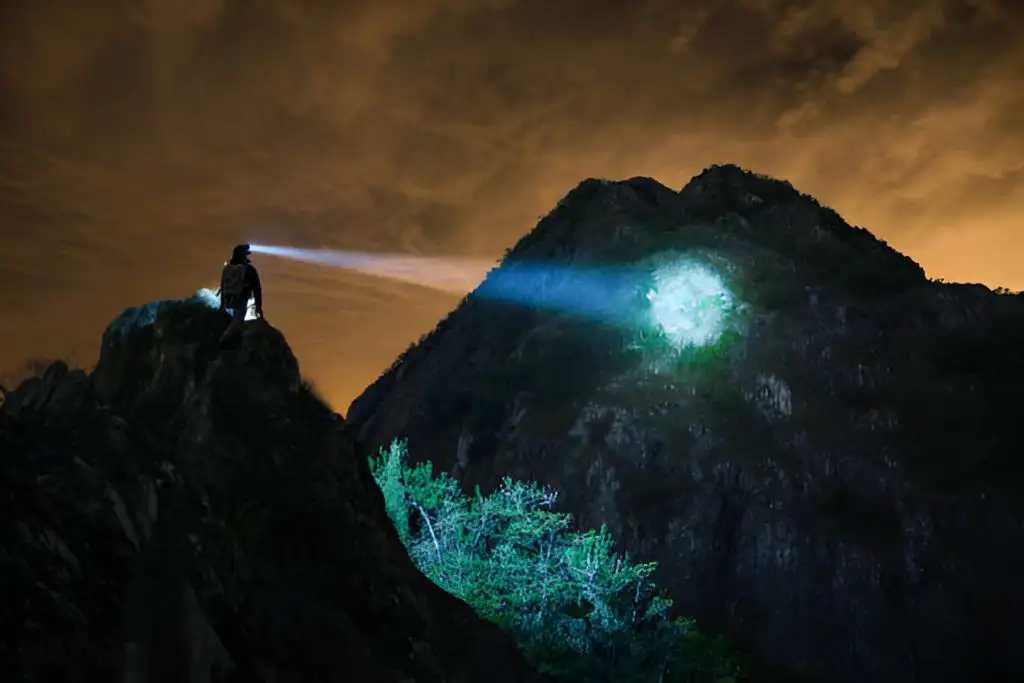
Nighttime Jungle Tours
As darkness falls, the Amazon comes alive with nocturnal creatures. Night tours offer a thrilling way to experience this hidden world. Equipped with flashlights, visitors follow guides along jungle trails. The beam of light might reveal glowing eyes of caimans in rivers or spot tree frogs on leaves. Lucky groups may see nocturnal mammals like kinkajous or night monkeys. Night safaris also showcase bioluminescent insects and plants. Guides often explain how animals adapt to darkness and hunt at night. These tours usually last 1-2 hours and require extra caution on trails.
Canopy Walks And Zip-Lining
Amazon canopy walkways offer a bird’s-eye view of the rainforest. Suspended bridges connect platforms high in the treetops. Visitors walk among branches that are usually out of reach. These elevated trails provide chances to spot canopy-dwelling animals. Colorful birds, monkeys, and sloths often appear at eye level. The panoramic views of the forest are breathtaking. For more excitement, some locations offer zip-lining between platforms. Adventurers can soar above the treetops, enjoying unique views and an adrenaline rush. Both activities require safety harnesses and guidance from trained staff.
Fishing For Piranhas And Other Adventures
Piranha fishing is a popular activity in calmer parts of the Amazon. Guides show visitors how to bait hooks and attract these famous fish. Caught piranhas are often cooked and eaten as part of the experience. Other fishing adventures target peacock bass or catfish. Some tours combine fishing with camping on riverbanks. This allows for early morning or night fishing sessions. Kayaking trips offer a more active way to explore rivers and lakes. Paddlers can access narrow channels and quiet backwaters. These trips often include opportunities for swimming in safe areas.
Cultural And Indigenous Experiences
The Peruvian Amazon offers rich opportunities to learn about indigenous cultures. Visitors can interact with tribes like the Yagua, Matsés, and Shipibo-Conibo. These communities welcome responsible tourists to experience their way of life.
During village visits, guests may observe:
• Traditional ceremonies
• Craft demonstrations
• Hunting and fishing techniques
It’s important to respect local customs and ask permission before taking photos.
Traditional medicine plays a key role in Amazon cultures. Shamans use plants like ayahuasca in healing rituals. These practices remain vital to many indigenous groups. Visitors can learn about medicinal plants on guided jungle walks. Some lodges offer workshops on plant-based remedies.
To ensure ethical tourism:
- Book through reputable tour operators
- Follow community guidelines
- Purchase crafts directly from artisans
The Amazon’s indigenous peoples maintain unique traditions despite outside pressures. Their deep connection to the forest shapes every aspect of life. Experiencing these cultures firsthand can be eye-opening for travelers. Responsible tourism helps support indigenous communities. It provides income while preserving cultural heritage. Visitors gain insight into sustainable ways of living in harmony with nature.
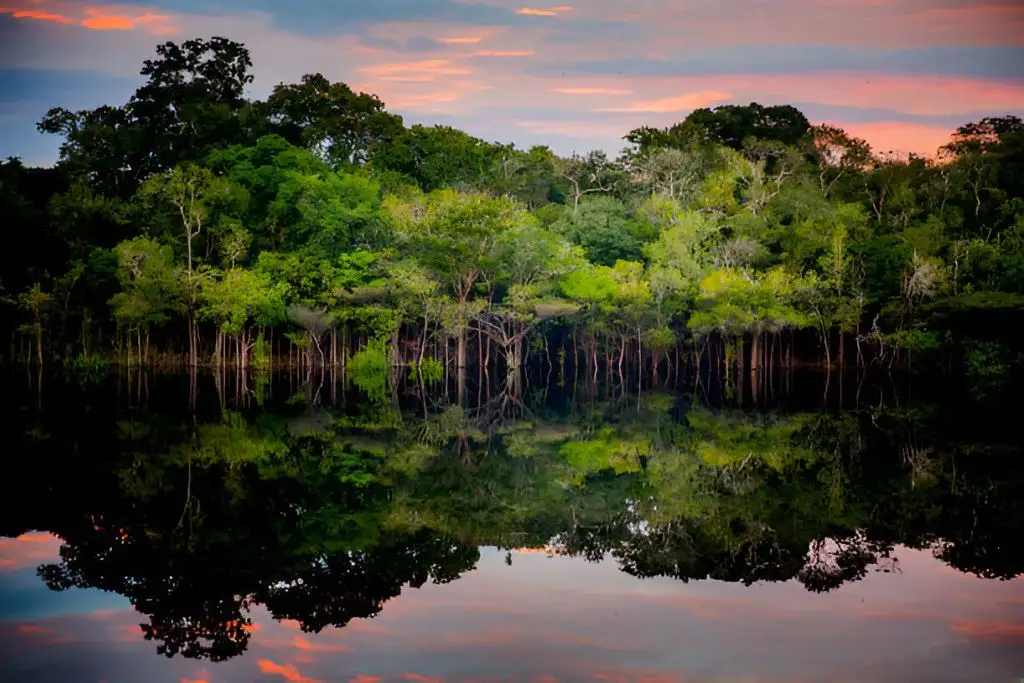
Things to Do in Peru’s Amazon Rainforest
The Amazon Rainforest in Peru is one of the most fascinating destinations because this majestic forest us surrounded by a fantastic biodiversity, adventure and culture. Options range from spotting exotic wildlife to staying and immersing oneself in an ecosystem through hikes, boat tours as welll visiting local families.CASCADE OF ACTIVITIES Tours of the Amazon can revolve on adventure tourism or eco-tourism and promise unforgettable adventures in the largest rainforest. From now until October is the ideal time to visit while touring this inimitable region and top ten things you could do here.
Wildlife Spotting
Witness iconic Amazonian wildlife like jaguars, sloths, monkeys, pink river dolphins, caimans and macaws/parrots. The Amazon hosts a dynamic, interactive array of wildlife that can be found only here. Joining a guided tour will immensely improve your chances of seeing these shy animals in the wild.
Jungle Treks
Among other activities, you will be able to discover the lush rainforest on guided walks and learn about plant life here with countless medicinal uses. Is means that trekking across the Amazon will deliver you in your journey of discovery surrounded by among the most numerous eco-systems imaginable and learn ways which were practiced for hundreds of years via native tribes.
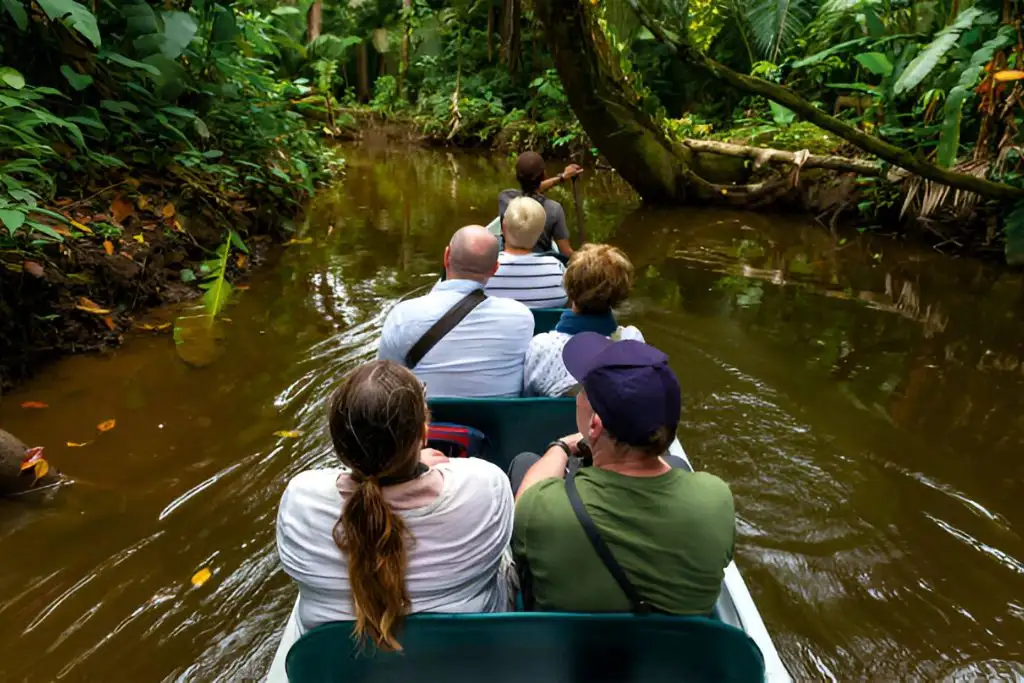
Boat Tours
Explore the Amazon River aboard a luxury cruise, searching for piranha and giant otters in tributary streams. These tours provide unique experiences of the Amazon from aboard a boat, allowing to see flora and fauna both aquatic and riverside in its natural habitat.
Canopy Walkways
Cross treetop bridges exposed to the elements for views of forest canopy and wildlife. Up in the canopy, it’s a riot of life: you can watch birds and monkeys there Liszka for their lives far above the forest floor.
Visit Indigenous Communities
Amazonian Indigenous tribes- local cultures, traditional crafts and daily life(rank 3) Few outsiders have had this opportunity to engage with the forests and tribal people, living in such difficult circumstances amid their environment and revealing how they provide for themselves.
Night Walks
Discover the night creature jungle, where tarantulas and even frog which only come out at nigh time as well nocturnal monkeys Evening walks are exciting evening outings that allow for the unveiling of jungle secrets, which remain hidden during daylight hours.

Fishing for Piranhas
Cast your line and angle to catch the infamous Amazonian fish while on specific fishing excursions. Brave, free-thinker adventurer and nature lover looking for an affordable taste of all the wonders Amazon.
Birdwatching
See hundreds of bird species, from toucans to parrots and imposing harpy eagles. The Amazon Rainforest is a birding haven, home to some of the most magnificent and exclusive species that have intrigued ornithologists all around the world for years!
Visit Clay Licks
Discover the wildlife of tropical birds parrots and macaws coming to clay licks. Clay licks are a natural phenomenon where flocks of birds gather together, offering vivid colors to the eye and also some great photographic opportunities.
Lodges And Accommodation In The Peruvian Amazon
The Peruvian Amazon offers a range of lodges and accommodations for visitors. These places provide comfort and access to the rainforest’s wonders.
Types Of Jungle Lodges
Amazon rainforest lodges come in different styles. Basic lodges have simple rooms and shared bathrooms. Mid-range lodges offer more comfort with private bathrooms and fans. Luxury lodges have air conditioning, hot water, and fancy meals. Many lodges are eco-lodges that focus on being kind to nature. They use solar power, collect rainwater, and follow green practices. These lodges often support local communities too. Some lodges float on rivers, giving guests a unique stay. Others sit high in the trees, offering amazing views of the forest canopy.
Recommended Lodges In Key Destinations
Near Iquitos, the Heliconia Jungle Lodge is great for families. It’s a 75-minute boat ride from the city. The rooms are simple but comfy. The Tahuayo Lodge is deep in the rainforest, about 150 km from Iquitos. Guests get a private guide and custom trips. For luxury, try Inkaterra Hacienda Concepción. It’s near Puerto Maldonado and offers top-notch amenities. Muyuna Lodge in the Tamshiyacu-Tahuayo Reserve is known for wildlife viewing. Guests can see monkeys, birds, and pink dolphins.
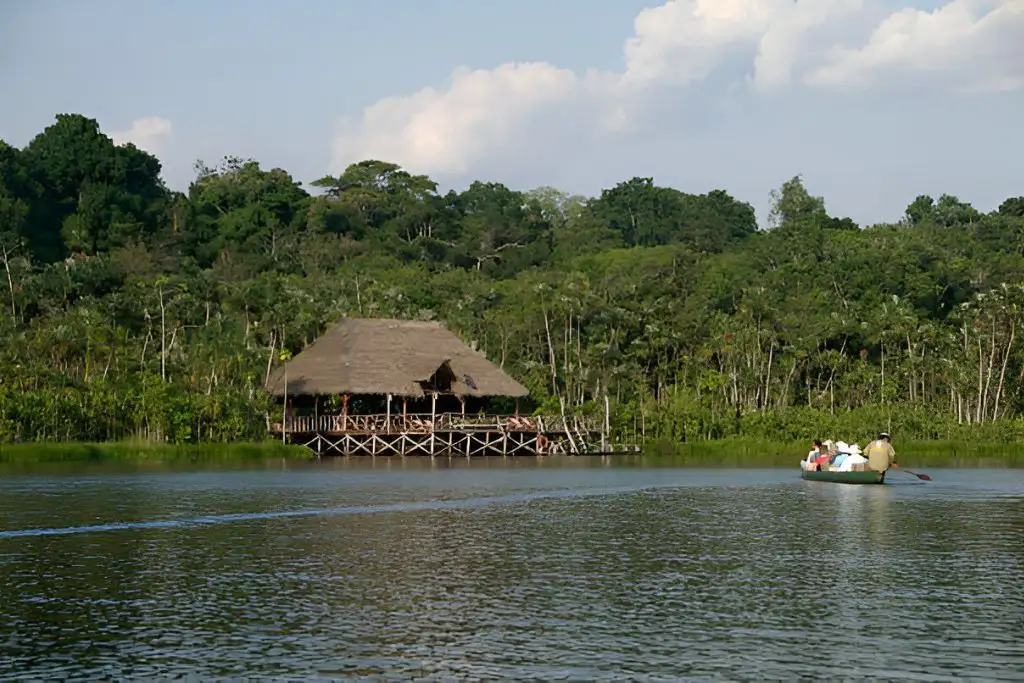
What To Expect At Amazon Lodges
Most Amazon lodges offer guided hikes, boat trips, and wildlife watching, with meals featuring local dishes. Rooms are simple, with mosquito nets, and electricity is often limited to generators or solar panels. Lodges usually provide rubber boots and rain gear, and some have viewing platforms for wildlife spotting. Activities may include night walks, fishing, and visits to local communities, with knowledgeable local guides leading tours. The jungle is hot and humid, and while lodges aim to keep guests comfortable, nature is always close at hand.
Conservation And Sustainable Travel In The Amazon
The Amazon rainforest faces threats from deforestation and illegal mining, but conservation efforts are in place. Travelers can help by choosing eco-friendly tours that support local communities and reduce environmental harm. Many lodges in Peru use sustainable practices, like conserving water and using clean energy. Guides encourage respect for nature, ensuring minimal impact on fragile areas. Some tours even let visitors participate in conservation projects. Buying local crafts supports native communities and helps protect the forest. Following park rules and permits also contributes to preserving the Amazon.
What To Pack For Your Amazon Rainforest Adventure
Amazon Trip Preparation requires smart Packing Wear light weight, quick dry clothing and it is best to wear long sleeves/ pants for sun protection / insect bites. Waterproof boots: dirty trail waterproof, hardy boots. A rain jacket is a must with the days of showers, and that wide brim hat for sun coverage. Pack DEET-based mosquito repellent and perhaps a mosquito net for some extra night time protection. See your GP about vaccinations and carry a decent basic first-aid kit. Binoculars for wildlife viewing and water proof cases to protect photography gear. Carrying a reusable water bottle is crucial for staying hydrated. Get the appropriate backpacking gear and you will be all set for your rainforest adventure.
Suggested Itineraries And Tour Packages
Peru’s Amazon rainforest offers diverse experiences for travelers. Tour options range from short stays to week-long adventures. Guided packages provide expert insights and convenient logistics.
3-Day, 5-Day, And 7-Day Itinerary Options
3-day Amazon trips give a quick taste of the rainforest. Visitors can take short hikes, spot wildlife, and learn about local plants. 5-day trips allow for deeper exploration. Travelers can visit indigenous communities and take night walks to see nocturnal animals.
7-day itineraries offer the most immersive experience. Guests can:
- Canoe through small tributaries
- Camp in the jungle
- Participate in longer treks
- Fish for piranhas
- Visit multiple ecosystems
These longer stays provide time to fully appreciate the Amazon’s biodiversity and cultures.
Guided Tour Packages
Guided Amazon tours offer expert-led experiences. Packages often include:
- Transportation from major cities
- Lodging in eco-friendly jungle lodges
- Meals featuring local cuisine
- Trained naturalist guides
- Safety equipment and first aid support
Some tours combine the Amazon with visits to Machu Picchu and Cusco. These multi-destination trips let travelers see Peru’s diverse landscapes and cultures in one journey. Specialized tours focus on birdwatching, photography, or wellness retreats. These cater to specific interests and skill levels.
Frequently Asked Questions
Many visitors have questions about exploring Peru’s Amazon rainforest. These FAQs cover key topics like entry requirements, safety tips, best times to visit, tour options, eco-friendly lodging, and reasons to include the Amazon in a Peru trip.
What are the entry requirements for visiting Peru’s Amazon rainforest?
Travelers need a valid passport, and some may require a visa. Most arrive in Peru via Lima, then fly to cities like Puerto Maldonado or Iquitos. Certain vaccinations may be recommended.
How can one ensure safety while exploring the Amazon in Peru?
Hire a reputable guide or tour company for safety. Use insect repellent, wear protective clothing, and drink bottled or purified water to avoid illness.
What are the best times of year to tour the Amazon rainforest in Peru?
The dry season (June to October) offers better hiking and fewer mosquitoes. The wet season (November to May) allows easier river travel.
What types of tours are available for the Amazon rainforest from cities like Cusco?
Multi-day tours often include flights to Puerto Maldonado, jungle lodges, and wildlife hikes. River cruises and shorter day trips are also available.
What accommodations are recommended for an eco-friendly stay in Peru’s Amazon?
Eco-friendly lodges using solar power and supporting local communities are popular. Some offer unique treehouse or stilted bungalow experiences.
Why should someone include the Amazon rainforest in their Peru travel itinerary?
The Amazon offers rich biodiversity and unique wildlife, along with cultural insights into indigenous traditions and plant medicine. It’s a great contrast to other Peru highlights like Machu Picchu.

